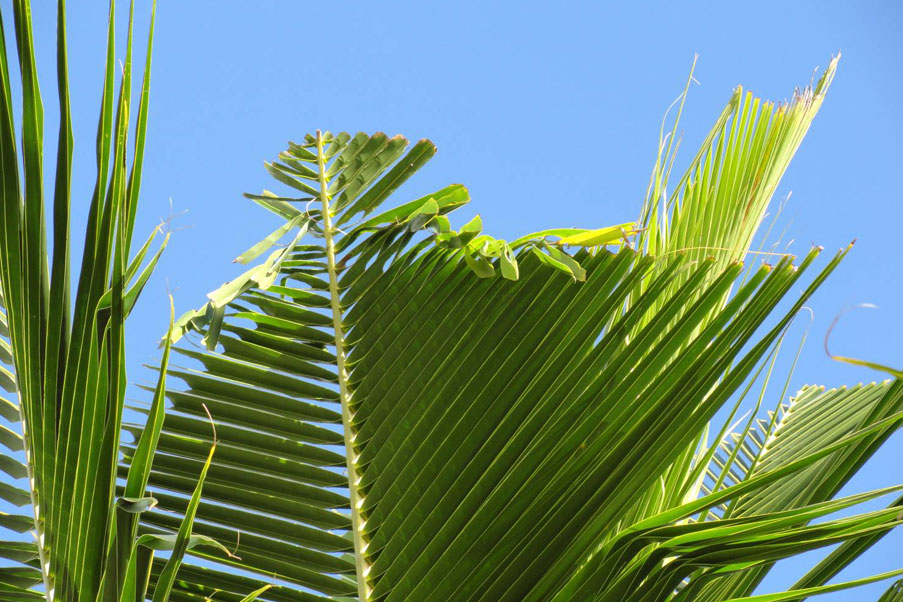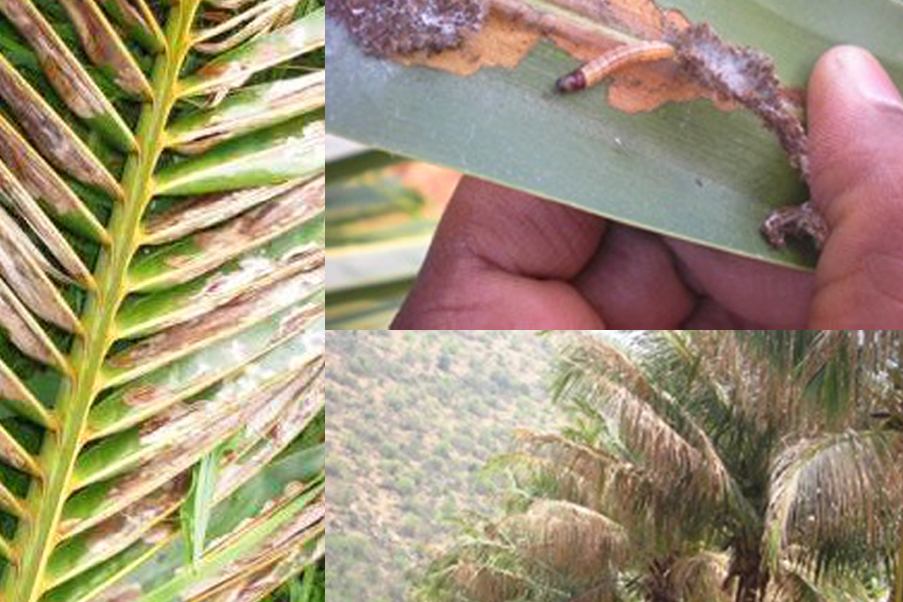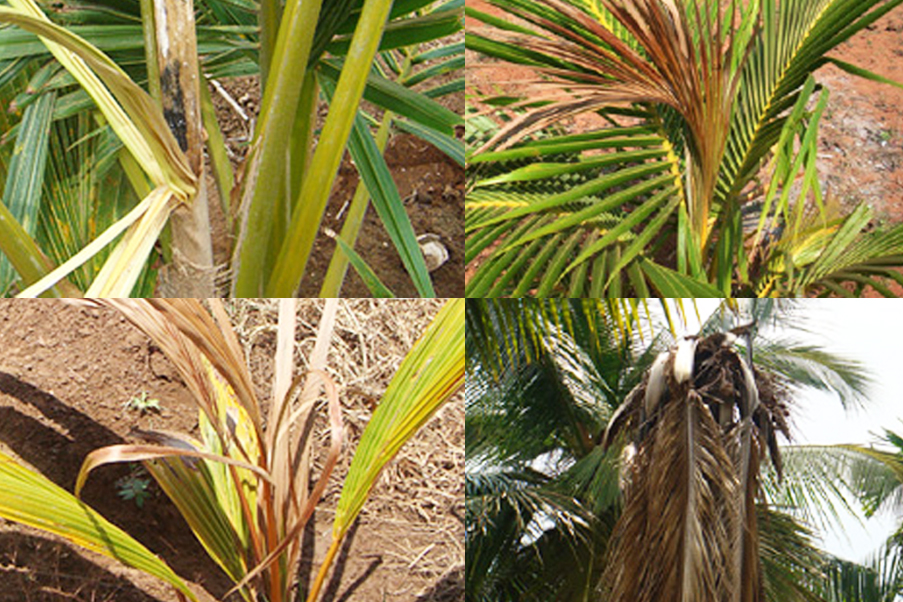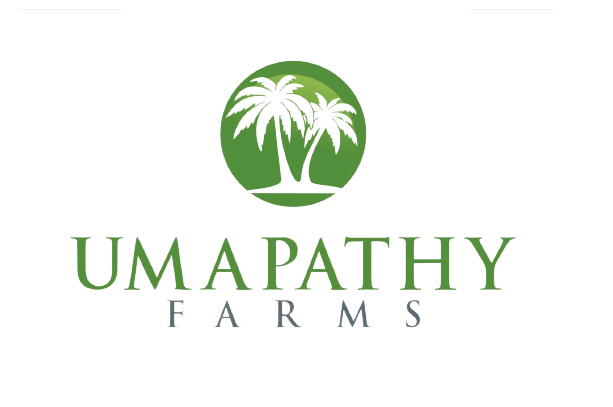The major insect pests of the coconut palm are the rhinoceros beetle, the red palm weevil, the black headed caterpillar, the cockchafer beetle and the coreid bug. Adopt suitable remedial measures as and when required. The following table gives the major symptoms and control measures.

Rhinoceros Beetle
Symptoms :
The adult beetle bores into the unopened fronds and spathes. Attacked fronds when fully opened show characteristic geometric cuts
Control measures :
Hook out the beetle from the attacked palms using beetle hook. As a prophylactic measure, fill up the top most three leaf axils with Sevidol 8G(25g) + fine sand (200g) thrice in April, September and December.

Red Palm Weevil
Symptoms :
Presence of holes on the stem, oozing out of viscous brown fluid and extrusion of chewed up fibres through the hole. Some times the gnawing sound produced by the feeding grubs will be audible.In the advanced stage of infestation yellowing of the inner whorl of leaves occur. The crown falls down or dry up later when palm is dead.
Control measures :
Practice clean cultivation by cutting and removing palms already damaged and the decaying stumps in the garden. Such palms should be split open and the different stages of pest inside burned off.

Black head Caterpillar
Symptoms :
Severity of attack is seen during January to May. The caterpillar feeds on green matter from lower leaf surface, remaining within silk and frass gallaries. In severe attack all the green matter of the leaves will be eaten up.
Control measures :
Bioligical control is very effective against this pest through release of parasitoids like Gorriozus nephantidis, Elasmus nephantidis and Brachimeria nosatoi.In case of severe attack, remove the affected leaves and destroy by burning.
DISEASES
The coconut palm is affected by a number of diseases, some of which are lethal while others gradually reduce the vigour of the palm causing severe loss in yield. A brief account of the important coconut diseases is given.

Bud Rot
Symptoms
1) The earlier symptom is the yellowing of one or two younger leaves. Black spots appear on spindle leaves.
2) In the later stages the spindle withers and drops down.
3) The tender leaf base and soft tissues of the crown rot into a slimy mass of decayed material emitting foul smell.
4) Ultimately the entire crown falls down and the palm dies.
Control measures
1) Remove all affected tissue of the crown and apply Bordeaux paste on cut end and provide a protective covering till normal shoot emerges (Dissolve 100 gm of copper sulphate and 100 gm of quick lime each in 500ml. water separately and mix to form 1 litre of Bordeaux paste).
2) Spray 1% Bordeaux mixture on the crown of the neighbouring palms as a prophylatic measure.
3) Spray with 1% Bordeaux mixture during May and September if the disease occur frequently.
4) Cut and burn severely affected palms which cannot be saved.

Leaf Rot
Symptoms :
1) Blackening and shriveling up of distal ends of the leaflets in the central spindle and younger leaves which later break off in bits.
2) Gradual weakening of the tree resulting in decline yield.
Control measures
1) Improve general condition of palms through proper manuring and management.
2) Remove the decayed portions of spindle leaf and upmost two leaves only.
3) Pour fungicide solution of Hexaconazol (Contaf 5E) – 2ml or Mancozeb (Dithane M45/Indifil M45) – 3g in 300ml water per palm to the base of spindle leaf.
4) Apply 20g Phorate 10G mixed with 200g fine sand around the base of spindle leaf.
5) 2-3 rounds of spraying is sufficient in case of mild infection.

Stem Bleeding
Symptoms :
1) Exudation of reddish brown liquid through cracks developing on the stem.
2) Decaying of tissues at bleeding point.
3) Vigour and yield declining.
4) Development of big holes inside the trunk
Control measures
1) Chisel affected tissue and dress the wound with 5% Calixin (5ml in 100ml water). Apply coal tar after 2 days. Burn off chiselled pieces.
2) Avoid any mechanical injury to the stem.
3) To avoid spread of disease on to upper portion of trunk, root feeding with 5% calixin may be adopted 3 times a year – April-May, Spetember-October and January-February.
4) Along with 50kg organic manure, apply 5kg neem cake containing the antagonistic fungi, Trichoderma culture to the basin during September.
5) Provide adequate irrigation during summer and drainage during rainy season.
6) Apply recommended doses of organic manures and chemical fertilizers.
7) Coconut stem boring insects like Xyleborus, Diocalandra should be controlled by applying Carbaryl 50% WP on the trunk @ 3g per litre water.

